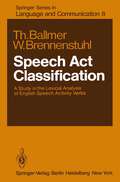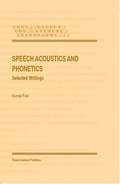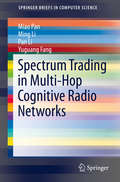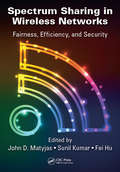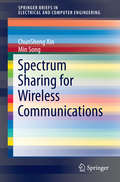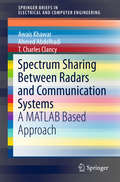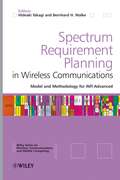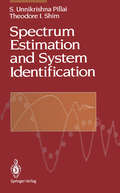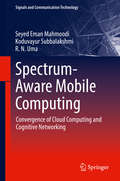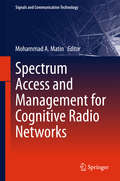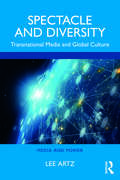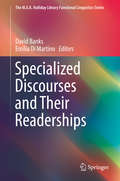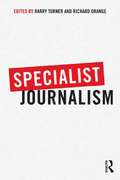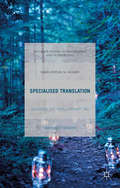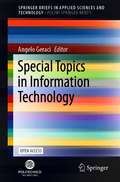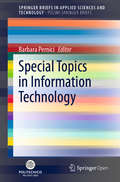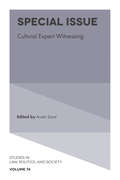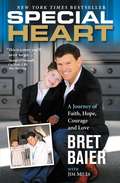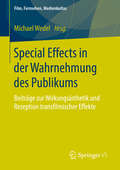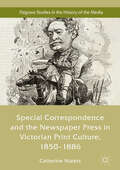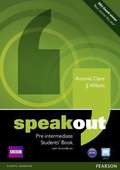- Table View
- List View
Speech Act Classification: A Study in the Lexical Analysis of English Speech Activity Verbs (Springer Series in Language and Communication #8)
by T. Ballmer W. BrennstuhlThis book presents a new classification of speech acts. It is an alter native to all previously published classifications of speech acts. The classification proposed here is based on an extensive set of data, name lyon all the verbs designating linguistic activities and aspects thereof. A theoretically and methodologically justifiable method is used to proceed in a number of steps from these data to the classification. The classification is documented in a lexicon with two sections. The first section exhibits the classification in all its details. Each verb is listed to its meaning at the appropriate place in the classification. according The second, alphabetically ordered section enables one to locate the verbs classified in the first part. The speech act classification as presented in this book has a number of consequences for linguistic theorizing: the book makes advances in three linguistically relevant fields - speech act theory, lexicology, and theory of meaning. In speech act theory firstly of course a classifica tion is proposed which is theoretically justified and which is simul taneously based explicitly and systematically on linguistic data. Second ly, a wider concept of speech acts is introduced which proves its value by making possible a linguistically justified classification. Thirdly, the concept of speech act sequence (or more generally partial order) is brought into focus as a major organizational principle of the semantic relation between speech acts.
Speech Acoustics and Phonetics: Selected Writings (Text, Speech and Language Technology #24)
by Gunnar FantThis book assembles major writings in speech production and phonetics of the pioneering Gunnar Fant, along with his more recent work on speech prosody. The book reviews the stages of the speech chain, covering production, speech data analysis and speech perception. 19 selected articles are grouped in 6 chapters, including a historical outline plus Speech production and synthesis; The voice source; Speech analysis and features; Speech perception; Prosody.
Spectrum Trading in Multi-Hop Cognitive Radio Networks (SpringerBriefs in Electrical and Computer Engineering #0)
by Miao Pan Ming Li Pan Li Yuguang FangThis SpringerBrief focuses on spectrum trading designs in multi-hop cognitive radio networks. It starts with the motivation for spectrum trading and the review of existing spectrum trading designs. Then, it presents a novel CRN architecture for spectrum trading considering spectrum trading’s economic features and wireless nature. Under this network architecture, it extends current single-hop per-user based spectrum trading design into a multi-hop transmission opportunity based one, and further into a session based one, while having economic properties guaranteed. This SpringerBrief not only provides a good review of current spectrum trading designs, it also touches on the cutting-edge interdisciplinary spectrum trading research on disparate fields of modeling, network architecture design, optimization theories, statistics, and economic theories. Advanced-level students studying computer science, electrical and computer engineering and economics, wireless network planners, and wireless spectrum engineers will find this book a useful tool.
Spectrum Sharing in Wireless Networks: Fairness, Efficiency, and Security
by John D. Matyjas, Sunil Kumar and Fei HuSpectrum Sharing in Wireless Networks: Fairness, Efficiency, and Security provides a broad overview of wireless network spectrum sharing in seven distinct sections: The first section examines the big picture and basic principles, explaining the concepts of spectrum sharing, hardware/software function requirements for efficient sharing, and future trends of sharing strategies. The second section contains more than 10 chapters that discuss differing approaches to efficient spectrum sharing. The authors introduce a new coexistence and sharing scheme for multi-hop networks, describe the space-time sharing concept, introduce LTE-U, and examine sharing in broadcast and unicast environments. They then talk about different cooperation strategies to achieve mutual benefits for primary users (PU) and secondary users (SU), discuss protocols in a spectrum sharing context, and provide different game theory models between PUs and SUs. The third section explains how to model the interactions of PUs and SUs, using an efficient calculation method to determine spectrum availability. Additionally, this section explains how to use scheduling models to achieve efficient SU traffic delivery. The subject of the fourth section is MIMO-oriented design. It focuses on how directional antennas and MIMO antennas greatly enhance wireless network performance. The authors include a few chapters on capacity/rate calculations as well as beamforming issues under MIMO antennas. Power control is covered in the fifth section which also describes the interference-aware power allocation schemes among cognitive radio users and the power control schemes in cognitive radios. The sixth section provides a comprehensive look at security issues, including different types of spectrum sharing attacks and threats as well as corresponding countermeasure schemes. The seventh and final section covers issues pertaining to military applications and examines how the military task protects its data flows when sharing the spectrum with civilian applications.
Spectrum Sharing in Wireless Networks: Fairness, Efficiency, and Security
by John D. Matyjas Sunil Kumar Fei HuSpectrum Sharing in Wireless Networks: Fairness, Efficiency, and Security provides a broad overview of wireless network spectrum sharing in seven distinct sections: The first section examines the big picture and basic principles, explaining the concepts of spectrum sharing, hardware/software function requirements for efficient sharing, and future trends of sharing strategies. The second section contains more than 10 chapters that discuss differing approaches to efficient spectrum sharing. The authors introduce a new coexistence and sharing scheme for multi-hop networks, describe the space-time sharing concept, introduce LTE-U, and examine sharing in broadcast and unicast environments. They then talk about different cooperation strategies to achieve mutual benefits for primary users (PU) and secondary users (SU), discuss protocols in a spectrum sharing context, and provide different game theory models between PUs and SUs. The third section explains how to model the interactions of PUs and SUs, using an efficient calculation method to determine spectrum availability. Additionally, this section explains how to use scheduling models to achieve efficient SU traffic delivery. The subject of the fourth section is MIMO-oriented design. It focuses on how directional antennas and MIMO antennas greatly enhance wireless network performance. The authors include a few chapters on capacity/rate calculations as well as beamforming issues under MIMO antennas. Power control is covered in the fifth section which also describes the interference-aware power allocation schemes among cognitive radio users and the power control schemes in cognitive radios. The sixth section provides a comprehensive look at security issues, including different types of spectrum sharing attacks and threats as well as corresponding countermeasure schemes. The seventh and final section covers issues pertaining to military applications and examines how the military task protects its data flows when sharing the spectrum with civilian applications.
Spectrum Sharing for Wireless Communications (SpringerBriefs in Electrical and Computer Engineering)
by ChunSheng Xin Min SongThis SpringerBrief presents intelligent spectrum sharing technologies for future wireless communication systems. It explains the widely used opportunistic spectrum access and TV white space sharing, which has been approved by the FCC. Four new technologies to significantly increase the efficiency of spectrum sharing are also introduced. The four technologies presented are Dynamic Spectrum Co-Access, Incentivized Cooperative Spectrum Sharing, On-Demand Spectrum Sharing and Licensed Shared Spectrum Access. These technologies shed light on future wireless communication systems and pave the way for innovative spectrum sharing with increased spectrum utilization. Increased utilization will allow networks to meet the demand for radio spectrum and promote the growth of wireless industry and national economy. Spectrum Sharing is a valuable resource for researchers and professionals working in wireless communications. Advanced-level students in electrical engineering and computer science will also find this content helpful as a study guide.
Spectrum Sharing Between Radars and Communication Systems: A MATLAB Based Approach (SpringerBriefs in Electrical and Computer Engineering)
by Awais Khawar Ahmed Abdelhadi T. Charles ClancyThis book presents spectrum sharing efforts between cellular systems and radars. The book addresses coexistence algorithms for radar and communication systems. Topics include radar and cellular system models; spectrum sharing with small radar systems; spectrum sharing with large radar systems; radar spectrum sharing with coordinated multipoint systems (CoMP); and spectrum sharing with overlapped MIMO radars. The primary audience is the radar and wireless communication community, specifically people in industry, academia, and research whose focus is on spectrum sharing. The topics are of interest for both communication and signal processing technical groups. In addition, students can use MATLAB code to enhance their learning experience.
Spectrum Requirement Planning in Wireless Communications: Model and Methodology for IMT - Advanced (Wireless Communications and Mobile Computing #2)
by Hideaki Takagi Bernhard H. WalkePresents the model and methodology, applied by ITU-R WRC’07, to calculate the spectrum requirement Spectrum Requirement Planning in Wireless Communications: Model and Methodology for IMT-Advanced is a self-contained “handbook” of the models and methodologies used for the spectrum requirement calculation for IMT-Advanced systems, as well as for the predecessor IMT-2000 systems. The reader will learn how the spectrum requirement is calculated for real systems that prevail worldwide. The book also provides the basis on which to develop advanced methodologies for yet future systems, as the spectrum regulation will continue in the future. Spectrum Requirement Planning in Wireless Communications: Model and Methodology for IMT-Advanced Provides the reader with information on how the spectrum requirement is calculated for real systems that prevail worldwide Contains useful tables and examples such as flowchart of the methodology Introduces definitions of service category and radio environment, the process of distributing traffic to radio environments, and the method to calculate the required spectrum Applies queueing and loss models for the calculation of required system capacity Covers utilization of radio frequencies, market data, spectrum requirement calculation methods for IMT-2000 and for IMT-Advanced systems Instructs how to use the calculation tool package Comes with an accompanying website with the downloadable tool applied by ITU-R WRC’07 for making decisions on spectrum regulation for mobile systems This book serves as an invaluable guide to engineers in mobile phone companies, system design engineers, operator system engineers and other specialists dealing with mobile system planning and development. It is also of great interest to researchers and graduate students in the fields of applied probability theory, operations research, telecommunications, and mobile networks engineering.
Spectrum Estimation and System Identification
by S.Unnikrishna Pillai Theodore I. ShimSpectrum estimation refers to analyzing the distribution of power or en ergy with frequency of the given signal, and system identification refers to ways of characterizing the mechanism or system behind the observed sig nal/data. Such an identification allows one to predict the system outputs, and as a result this has considerable impact in several areas such as speech processing, pattern recognition, target identification, seismology, and signal processing. A new outlook to spectrum estimation and system identification is pre sented here by making use of the powerful concepts of positive functions and bounded functions. An indispensable tool in classical network analysis and synthesis problems, positive functions and bounded functions are well and their intimate one-to-one connection with power spectra understood, makes it possible to study many of the signal processing problems from a new viewpoint. Positive functions have been used to study interpolation problems in the past, and although the spectrum extension problem falls within this scope, surprisingly the system identification problem can also be analyzed in this context in an interesting manner. One useful result in this connection is regarding rational and stable approximation of nonrational transfer functions both in the single-channel case and the multichannel case. Such an approximation has important applications in distributed system theory, simulation of systems governed by partial differential equations, and analysis of differential equations with delays. This book is intended as an introductory graduate level textbook and as a reference book for engineers and researchers.
Spectrum-Aware Mobile Computing: Convergence of Cloud Computing and Cognitive Networking (Signals and Communication Technology)
by Seyed Eman Mahmoodi Koduvayur Subbalakshmi R. N. UmaThis book presents solutions to the problems arising in two trends in mobile computing and their intersection: increased mobile traffic driven mainly by sophisticated smart phone applications; and the issue of user demand for lighter phones, which cause more battery power constrained handhelds to offload computations to resource intensive clouds (the second trend exacerbating the bandwidth crunch often experienced over wireless networks). The authors posit a new solution called spectrum aware cognitive mobile computing, which uses dynamic spectrum access and management concepts from wireless networking to offer overall optimized computation offloading and scheduling solutions that achieve optimal trade-offs between the mobile device and wireless resources. They show how in order to allow these competing goals to meet in the middle, and to meet the promise of 5G mobile computing, it is essential to consider mobile offloading holistically, from end to end and use the power of multi-radio access technologies that have been recently developed. Technologies covered in this book have applications to mobile computing, edge computing, fog computing, vehicular communications, mobile healthcare, mobile application developments such as augmented reality, and virtual reality.
Spectrum Access and Management for Cognitive Radio Networks (Signals and Communication Technology)
by Mohammad A MatinThis book presents cutting-edge research contributions that address various aspects of network design, optimization, implementation, and application of cognitive radio technologies. It demonstrates how to make better utilization of the available spectrum, cognitive radios and spectrum access to achieve effective spectrum sharing between licensed and unlicensed users. The book provides academics and researchers essential information on current developments and future trends in cognitive radios for possible integration with the upcoming 5G networks. In addition, it includes a brief introduction to cognitive radio networks for newcomers to the field.
Spectacle and Diversity: Transnational Media and Global Culture (ISSN)
by Lee ArtzThis book shows how transnational media operate in the contemporary world and what their impact is on film, television, and the larger global culture. Where a company is based geographically no longer determines its outreach or output. As media consolidate and partner across national and cultural boundaries, global culture evolves. The new transnational media industry is universal in its operation, function, and social impact. It reflects a shared transnational culture of consumerism, authoritarianism, cultural diversity, and spectacle. From Wolf Warriors and Sanju to Valerian: City of 1000 Planets and Pokémon, new media combinations challenge old assumptions about cultural imperialism and reflect cross-boundary collaboration as well as boundary-breaking cultural interpretation. Intended for students of global studies and international communication at all levels, the book will appeal to a wide range of readers interested in the way transnational media work and how that shapes our culture.
Spectacle and Diversity: Transnational Media and Global Culture (ISSN)
by Lee ArtzThis book shows how transnational media operate in the contemporary world and what their impact is on film, television, and the larger global culture. Where a company is based geographically no longer determines its outreach or output. As media consolidate and partner across national and cultural boundaries, global culture evolves. The new transnational media industry is universal in its operation, function, and social impact. It reflects a shared transnational culture of consumerism, authoritarianism, cultural diversity, and spectacle. From Wolf Warriors and Sanju to Valerian: City of 1000 Planets and Pokémon, new media combinations challenge old assumptions about cultural imperialism and reflect cross-boundary collaboration as well as boundary-breaking cultural interpretation. Intended for students of global studies and international communication at all levels, the book will appeal to a wide range of readers interested in the way transnational media work and how that shapes our culture.
Specialized Discourses and Their Readerships (The M.A.K. Halliday Library Functional Linguistics Series)
by David Banks Emilia Di MartinoThis volume studies the relationship between the writers of specialized text and their readers in a broad range of settings, including research, popularization and education. It offers younger researchers an insight into the targeting process, helping them consider the impact their work can have, and showing them how to achieve greater exposure. Further, it offers an invaluable reflective instrument for beginning and experienced researchers, drawing on a veritable treasure trove of their colleagues’ experience. As such, it represents a way for researchers and students in linguistics and related disciplines to access issues from a different, insider perspective.Reader targeting has become a very sophisticated process, with authors often addressing their potential readers even in video. Compared to other forms of writing, academic writing stands out because authors are, in the majority of cases, also consumers of the same type of products, which makes them excellent “targeters.”
Specialist Journalism
by Barry Turner Richard OrangeCombining practical 'how to' skills with reflection on the place of each specialism in the industry, this guide features the skills needed to cover specialist areas, including writing match reports for sport, reviewing the arts, and dealing with complex information for science. The book will also discuss how specialist journalists have contributed to the mainstream news agenda, as well as analysing how different issues have been covered in each specialism, such as the credit crunch, global warming, national crime statistics and the celebrity culture in sport. Areas covered include: Sport Business Politics Crime Environment Fashion Food Music Media Science Health Law Travel War Wine
Specialist Journalism
by Barry Turner Richard OrangeCombining practical 'how to' skills with reflection on the place of each specialism in the industry, this guide features the skills needed to cover specialist areas, including writing match reports for sport, reviewing the arts, and dealing with complex information for science. The book will also discuss how specialist journalists have contributed to the mainstream news agenda, as well as analysing how different issues have been covered in each specialism, such as the credit crunch, global warming, national crime statistics and the celebrity culture in sport. Areas covered include: Sport Business Politics Crime Environment Fashion Food Music Media Science Health Law Travel War Wine
Specialised Translation: Shedding the 'Non-Literary' Tag (Palgrave Studies in Translating and Interpreting)
by M. RogersThis book shifts the common perception of specialised or 'LSP' translation as necessarily banal and straightforward towards a more realistic understanding of it as a complex and multilayered phenomenon which belies its standard negative binary definition as 'non-literary'.
Special Topics in Information Technology (SpringerBriefs in Applied Sciences and Technology)
by Angelo GeraciThis open access book presents thirteen outstanding doctoral dissertations in Information Technology from the Department of Electronics, Information and Bioengineering, Politecnico di Milano, Italy. Information Technology has always been highly interdisciplinary, as many aspects have to be considered in IT systems. The doctoral studies program in IT at Politecnico di Milano emphasizes this interdisciplinary nature, which is becoming more and more important in recent technological advances, in collaborative projects, and in the education of young researchers. Accordingly, the focus of advanced research is on pursuing a rigorous approach to specific research topics starting from a broad background in various areas of Information Technology, especially Computer Science and Engineering, Electronics, Systems and Control, and Telecommunications. Each year, more than 50 PhDs graduate from the program. This book gathers the outcomes of the thirteen best theses defended in 2019-20 and selected for the IT PhD Award. Each of the authors provides a chapter summarizing his/her findings, including an introduction, description of methods, main achievements and future work on the topic. Hence, the book provides a cutting-edge overview of the latest research trends in Information Technology at Politecnico di Milano, presented in an easy-to-read format that will also appeal to non-specialists.
Special Topics in Information Technology (SpringerBriefs in Applied Sciences and Technology)
by Barbara PerniciThis open access book presents nine outstanding doctoral dissertations in Information Technology from the Department of Electronics, Information and Bioengineering, Politecnico di Milano, Italy. Information Technology has always been highly interdisciplinary, as many aspects have to be considered in IT systems. The doctoral studies program in IT at Politecnico di Milano emphasizes this interdisciplinary nature, which is becoming more and more important in recent technological advances, in collaborative projects, and in the education of young researchers. Accordingly, the focus of advanced research is on pursuing a rigorous approach to specific research topics starting from a broad background in various areas of Information Technology, especially Computer Science and Engineering, Electronics, Systems and Controls, and Telecommunications. Each year, more than 50 PhDs graduate from the program. This book gathers the outcomes of the nine best theses defended in 2018-19 and selected for the IT PhD Award. Each of the nine authors provides a chapter summarizing his/her findings, including an introduction, description of methods, main achievements and future work on the topic. Hence, the book provides a cutting-edge overview of the latest research trends in Information Technology at Politecnico di Milano, presented in an easy-to-read format that will also appeal to non-specialists.
Special Issue: Cultural Expert Witnessing (Studies in Law, Politics, and Society #74)
by Austin SaratStudies in Law, Politics, and Society provides a vehicle for the publication of scholarly articles within the broad parameters of interdisciplinary legal scholarship. In this latest edition of this highly successful research series, chapters examine a diverse range of legal issues and their impact on and intersections with society. This volume is a collection of chapters exploring expert witnessing in Asylum Cases. Topics covered include: judicial ethnocentrism, political asylum, race identity and cultural defense. This volume brings together leading scholars and will be vital reading for all those researching in this subject area.
Special Issue: Cultural Expert Witnessing (Studies in Law, Politics, and Society #74)
by Austin SaratStudies in Law, Politics, and Society provides a vehicle for the publication of scholarly articles within the broad parameters of interdisciplinary legal scholarship. In this latest edition of this highly successful research series, chapters examine a diverse range of legal issues and their impact on and intersections with society. This volume is a collection of chapters exploring expert witnessing in Asylum Cases. Topics covered include: judicial ethnocentrism, political asylum, race identity and cultural defense. This volume brings together leading scholars and will be vital reading for all those researching in this subject area.
Special Heart: A Journey of Faith, Hope, Courage and Love
by Bret BaierFox News Channel anchor Bret Baier shares the New York Times bestselling story of his son Paul's ongoing battle with heart disease, and how it transformed his own life and family.This deeply touching personal story is told through the eyes of a journalist as he faces his life's greatest crisis: caring for his critically ill son. With the acute insight of a seasoned reporter, and the deep love of a husband and father, Baier shares behind-the-scenes stories and emotional narrative of young Paul's life thus far. Bret and his wife Amy emerge-just like their brave young son-scarred but infinitely stronger, and clearly understanding what matters most in life. Told by a loving father and master storyteller, this hope-filled account offers an inspirational glimpse into the family of a man who just happens to be someone millions turn to for the day's news.One hundred percent of what the author receives from the sale of this book is donated to various non-profit pediatric heart causes.
Special Effects in der Wahrnehmung des Publikums: Beiträge zur Wirkungsästhetik und Rezeption transfilmischer Effekte (Film, Fernsehen, Medienkultur)
by Michael WedelDie film- und medienwissenschaftliche Diskussion zum Thema Special Effects wird bisher von Fragen nach der Produktionsweise und technischen Realisierbarkeit dominiert. Der Band versammelt theoretische Grundlagentexte zu einer Wirkungsästhetik der Special Effects und verbindet sie mit konkreten Fallstudien zur kulturellen Wahrnehmung und empirischen Publikumsrezeption in verschiedenen Mediengattungen von Film und Fernsehen bis hin zu Internet-Videos und Computerspielen.
Special Correspondence and the Newspaper Press in Victorian Print Culture, 1850–1886 (Palgrave Studies in the History of the Media)
by Catherine WatersThis book analyses the significance of the special correspondent as a new journalistic role in Victorian print culture, within the context of developments in the periodical press, throughout the second half of the nineteenth century. Examining the graphic reportage produced by the first generation of these pioneering journalists, through a series of thematic case studies, it considers individual correspondents and their stories, and the ways in which they contributed to, and were shaped by, the broader media landscape. While commonly associated with the reportage of war, special correspondents were in fact tasked with routinely chronicling all manner of topical events at home and abroad. What distinguished the work of these journalists was their effort to ‘picture’ the news, to transport readers imaginatively to the events described. While criticised by some for its sensationalism, special correspondence brought the world closer, shrinking space and time, and helping to create our modern news culture.
Speakout Pre-intermediate Students Book: With Active Book
by Antonia Clare J J Wilson'Speakout' is a 6-level general English course for adults developed in association with the BBC; bridging the gap between the classroom and the real world helping students express themselves in English.
